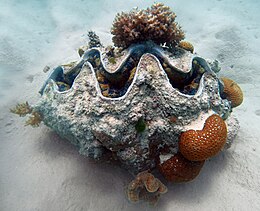
Back بصر (محار) Arabic بصر ARZ Трыдакна гіганцкая Byelorussian Гигантска мида тридакна Bulgarian Cloïssa gegant Catalan Tridacna gigas CEB Zéva obrovská Czech Giganta tridakno Esperanto Tridacna gigas Spanish Suur rõõneskarp Estonian
| Giant clam | |
|---|---|

| |
| T. gigas, Michaelmas Cay Great Barrier Reef, Queensland, Australia | |
| Scientific classification | |
| Domain: | Eukaryota |
| Kingdom: | Animalia |
| Phylum: | Mollusca |
| Class: | Bivalvia |
| Order: | Cardiida |
| Family: | Cardiidae |
| Genus: | Tridacna |
| Species: | T. gigas
|
| Binomial name | |
| Tridacna gigas | |
| Synonyms[3] | |
|
Chama gigantea Perry, 1811 | |

Tridacna gigas, the giant clam, is the most well-known species of the giant clam genus Tridacna. Giant clams are the largest living bivalve mollusks. Several other species of "giant clams" in the genus Tridacna, are often misidentified as Tridacna gigas.
Known to indigenous peoples of East Asia for thousands of years, the Venetian scholar and explorer Antonio Pigafetta documented these clams in a journal as early as 1521. One of a number of large clam species native to the shallow coral reefs of the South Pacific and Indian oceans, they may weigh more than 200 kilograms (440 lb), measure as much as 120 cm (47 in) across, and have an average lifespan in the wild of more than 100 years.[4] They also are found off the shores of the Philippines and in the South China Sea in the coral reefs of Malaysia.[5]
The giant clam lives in flat coral sand or broken coral and may be found at depths of as great as 20 m (66 ft).[6]: 10 Its range covers the Indo-Pacific, but populations are diminishing quickly and the giant clam has become extinct in many areas where it was once common.[5] The maxima clam has the largest geographical distribution among giant clam species; it may be found off high- or low-elevation islands, in lagoons or fringing reefs.[7] Its rapid growth rate is likely due to its ability to cultivate algae in its body tissue.[6]: 10
Although larval clams are planktonic, they become sessile in adulthood.[8] The creature's mantle tissues act as a habitat for the symbiotic single-celled dinoflagellate algae (zooxanthellae) from which the adult clams get most of their nutrition. By day, the clam opens its shell and extends its mantle tissue so that the algae receive the sunlight they need to photosynthesise. This method of algal farming is under study as a model for highly efficient bioreactors.
- ^ Wells, S. (1996). Tridacna gigas. The IUCN Red List of Threatened Species doi:10.2305/IUCN.UK.1996.RLTS.T22137A9362283.en
- ^ "Appendices | CITES". cites.org. Archived from the original on 3 February 2007. Retrieved 14 January 2022.
- ^ Bouchet, P.; Huber, M. (2013). "Tridacna gigas (Linnaeus, 1758)". WoRMS. World Register of Marine Species. Retrieved 9 April 2014.
- ^ "Giant Clam: Tridacna gigas". National Geographic Society. Archived from the original on 15 April 2021. Retrieved 19 November 2023.
- ^ a b Syukri bin Othman, Ahmad; Goh, Gideon H. S.; Todd, Peter A. (28 February 2010). "THE DISTRIBUTION AND STATUS OF GIANT CLAMS (FAMILY TRIDACNIDAE) – A SHORT REVIEW". The Raffles Bulletin of Zoology. 58 (1): 103–111.
- ^ a b Knop, Daniel (1996). Giant clams: a comprehensive guide to the identification and care of Tridacnid clams. Ettlingen: Dähne Verlag. ISBN 978-3-921684-23-8. OCLC 35717617.
- ^ Cite error: The named reference
Munrowas invoked but never defined (see the help page). - ^ Cite error: The named reference
:2was invoked but never defined (see the help page).
